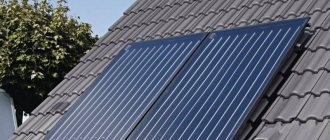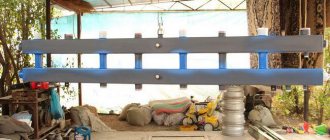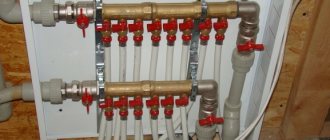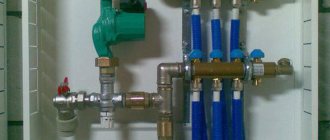A little about payback
If we compare the cost of connecting to a gas pipeline and installing collectors, they are quite comparable. But gas is a budget expense, while the operation of a vacuum collector requires a minimum of electricity, and even then only for pumping the coolant. Practice shows that for heating a house in winter, a vacuum solar collector is much more profitable than other heat sources.
Another point regarding payback is the service life of the equipment. In a heating system based on tubular solar collectors, there are no complex parts or parts that are subject to wear. With periodic maintenance, such a system will last for decades.
Use of solar collectors in Europe and Russia
Residents of Europe have long come to the conclusion that using solar systems is profitable, comfortable and environmentally friendly. The absolute leader in European progress is Germany, followed by Greece; in Austria, 15% of private houses are equipped with DHW collectors. In Europe, solar collectors work everywhere - in private homes, schools, kindergartens, hospitals, and on farms. In Portugal, Israel and Spain, the installation of solar collectors that heat water is mandatory when building new houses.
The areas occupied by solar systems in Europe, America, Japan, and China are millions of square km, while in Russia this figure is 30,000 km2. There are several reasons - poor awareness of people and low levels of income.
Today, along with German, Austrian and Swiss manufacturers, Russian machine-building plants, as well as Belarusian and Ukrainian manufacturers, are entering the market of CIS countries, selling solar power plants at prices lower than their foreign counterparts.
Design and principle of operation

A solar collector is a thermal converter of solar energy that collects radiation (solar) regardless of air temperature. Installation is carried out at an angle of 5-90°, which makes it possible to install it so that the working surface is maximally aimed at generating energy.
The main component of the design of vacuum solar collectors is a glass tube, which is mounted in the frame (panel) of the collector. Several similar tubes are installed in one panel; depending on the design, their number may vary.
The tube consists of several components, these are:
- Glass tube with a solar-absorbing layer;
- A smaller diameter copper tube placed in a glass tube.
There is a vacuum space between the tubes.

The operating principle of such devices is as follows
- The sun's rays fall on glass tubes treated with a special layer and their energy is absorbed by this structural element.
- Tubes of smaller diameter contain a special liquid, which, under the influence of energy absorbed by the absorber (glass tubes with an absorbing layer), heats up and, when certain parameters are reached, evaporates. In the vapor state, the substance rises to the top of the tubes.
- Sets of tubes are placed in a common block in which they are in contact with the circulating coolant.
- In the vapor state, energy is transferred to the coolant, after which the substance condenses and flows down in the liquid state.
- The process repeats again.
Operating principle of vacuum tubes
The function of evacuated solar collector tubes is to absorb solar radiation and prevent it from escaping into the environment. Thermal energy can leave the working part of a vacuum solar collector in two ways - due to direct heat transfer and in the form of infrared radiation.
The cavity between the glass walls almost completely eliminates possible direct heat transfer; in a vacuum there are no molecules of substances that could carry out its transfer.
Selective coating (absorbent) ensures absorption of solar energy and does not allow it to escape outside. There are different types of such coatings, differing in absorption and emissivity.
Some of the solar radiation is reflected by glass, but it is insignificant - visible light makes up only part of the absorbed spectrum. High-quality collectors are made from high-strength borosilicate glass, which is resistant to mechanical damage.
Borosilicate glass is difficult to scratch or frost and lasts for decades without changing its transmission capacity.
Features of operation
The main problem for all types of solar equipment during the cold season is precipitation. If the tubes are covered with snow or frost, their effectiveness will be reduced. But it is worth considering the following:
- How to make a solar collector for heating with your own hands?
If you are going to use a vacuum solar collector to heat your home in winter, then it will be installed at a large angle to catch maximum sunlight. Accordingly, snow and water will simply slide off it.
The small area of the tubes will not allow snow to “catch” on them, unlike what happens with flat-plate solar collectors. Practice shows that a wind of 3 m/s blows snow off the collectors.
The biggest danger is caused by ice. It forms when the temperature is above zero during the day and below zero at night. Ice, although transparent, scatters some of the sunlight. The formation of an ice crust somewhat reduces the efficiency of the solar vacuum collector.
It’s easy to get rid of – just pour warm water over the frozen area. It is not recommended to chip ice from vacuum tubes - there is a risk of damaging the glass and breaking the seal.
How to assemble the unit with your own hands?
The process of assembling a vacuum manifold begins with the manufacture of a support frame for the working elements. It is installed immediately in the place allocated for the unit.
The size and dimensions of the frame depend entirely on the model that is planned to be made, and are usually prescribed in the instructions found among the accompanying documents for the components.
The finished frame for the collector is fixed to the roof so that it occupies a clear position and does not swing. If the roof of the building is slate, use sheathing beams and large-caliber thick screws. For other roofing materials, conventional anchors are used
I additionally fix the places where the frame meets the roof surface with sealant so that in the future water does not enter the house through the holes. Then the storage tank is delivered to the installation site and secured with screws to the top of the frame.
At the next stage, the heating element, temperature sensor and automated air outlet are assembled. All auxiliary components and related parts are placed on the included softening pads. To attach the temperature sensor, use a socket wrench.
Next, the supply of water supply communications is arranged. For this purpose, pipes are taken from any material that is resistant to low temperatures and can withstand up to 95 degrees of heat.
Polypropylene pipes are ideal for connecting the solar collector to the residential plumbing system. The reinforcement has good physical properties and operational endurance, serves reliably for many years and is easily replaced in case of cracks or tears.
Having connected the water supply, the storage tank is filled with water and tested for leaks. If leaks are found somewhere within 3-4 hours, they are repaired.
At the end, heating elements are installed. To do this, the copper tube is wrapped in aluminum sheet and placed in a glass vacuum tube. From below, a fixing cup and a boot made of durable, flexible rubber are placed on the flask.
The upper copper tip of the tube is pushed all the way into the brass condenser. Viscous thermal contact grease is not removed from the pipes. Snap the locking mechanism onto the bracket and mount all remaining glass tubes using the same principle.

Tubular solar collectors require regular maintenance and mandatory cleaning, especially during periods of active snowfall. If you follow these simple rules, they will work for a long time and maintain a high level of efficiency throughout their entire service life.
A mounting block is placed on the structure, a 220-volt power supply is supplied to it, and three auxiliary units are connected to the system - a heating element, an air vent and a temperature sensor.
The last thing to connect is a controller designed to correctly control the complex. The desired operating parameters are entered into the controller menu and the system starts in standard mode.
Types of vacuum solar collectors
The most popular and in demand types are divided according to the type of collector design.
They are:
- Vacuum flask with heat pipe. They are difficult to operate and manufacture, because... In this type of design, vacuum-type thermal insulation is provided throughout the entire flask. These devices provide the highest efficiency. The absorber here is a plate that is covered with a selective all-absorbing coating. The heat pipe is securely attached to the plate and supplies energy to the capacitor (top of the tube). In turn, the condenser is connected to the collector heat exchanger. This is where the coolant heats up.
- “Falk in a flask” with a heat pipe. This design is slightly simpler than the previous one and has lower performance at lower temperatures. The absorbent surface is located on the inner tube. Heat is transferred to the heat pipe, made of copper, through metal fins. A heat pipe is the most efficient device designed to transfer heat.
- "A flask in a flask." This type of vacuum collector device makes it possible to achieve the highest degree of thermal insulation of the coating (absorbing), without interfering with the penetration of sunlight. As with the previous type, the energy absorption coating is located on the inner bulb. The coolant that is in contact with the absorbing surface can be heated without intermediate transformations.
What should the heat collector be like?
The heat collector is another very important working element of the vacuum manifold. Through this unit, accumulated heat is transferred from the tubes to the coolant.
The heat collector is located at the top of the device. One of its components, a copper core, receives energy and transfers it to the main coolant circulating in a closed tank-collector heat exchanger system.
Correct operation is guaranteed by a circulation pump connected to the system. The automation that controls the heating complex clearly monitors the temperature level in the channels and, if it falls below the permissible critical minimum (for example, at night), stops the pump.
This allows you to avoid backheating, when the coolant begins to take away the heat of the hot water collected in the storage tank.
Model overview
Summer resident
Collector Summer Resident
This model costs about 18,500 rubles. This collector is capable of heating water up to 95 degrees and is perfect for country houses. Has a 12 month manufacturer's warranty. This time is enough to ensure its reliability.
This model has the following technical characteristics:
- The 100 liter tank is made of high quality stainless steel.
- The vacuum tube is 150 cm long.
- Tube diameter (external) 4.8 cm.
- The maximum possible pressure in the tube is 0.6 MP.
- The design is resistant to hail up to 0.5 cm.
- The tubes are made of borosilicate glass, which has an absorbing effect.
- The total weight of the collector is 45 kg.
Equipment:
- set of anthers (sealing) – 1 pc.;
- vacuum tubes – 16 pieces;
- frame and set of bolts – 1 pc.;
- expansion tank – 1 pc.;
- thermos tank 100 l. - 1 PC.;
CP-II-20-175 from ANDI Group
Manifold CP-II-20-175 from ANDI Group
The kit includes:
- Solar collectors
- water tank with a volume of 175 l., the internal circuit is made of stainless steel, and the external circuit is made of galvanized painted steel;
- vacuum tubes – 20 pcs.;
- TNC-2 (controller).;
The thermal insulation of the tank is made of polyurethane (50 mm). Internal diameter 36 cm, external 46 cm, steel frame 1.5 mm thick, galvanized. Net weight of the unit is 86 kg.
Homemade collector
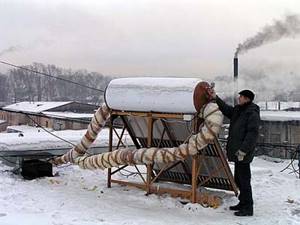
To make a collector you will need:
- Vacuum tubes - the quantity is determined by the designer. Industrial tubes are used.
- Block concentrator - depending on the number of tubes, one or another size of the device is selected. An industrial production unit is used.
- Materials for making the frame.
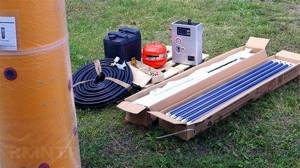
Manifold components
The collector frame is made; for this you can use lumber or metal profile elements. The concentrator and vacuum tubes are mounted on the frame in the following sequence:
- Heat-conducting plates and plugs are placed on the copper rod.
- The rod is installed in a vacuum flask.
- The fixing cups are put on.
- A protective boot is put on.
- The rod is placed in a block concentrator.
- The process is repeated with the next tube.
After assembly, the solar collector is mounted on a prepared plane, and the following conditions must be taken into account, such as:
- during installation, the collector should be oriented to the south;
- create conditions to prevent shading of the collector;
- create protection against overheating;
- securely fasten the collector to the prepared surface.

Polycarbonate manifold
They are made from honeycomb panels with good thermal insulation properties. Sheet thickness from 4 to 30 mm. The choice of polycarbonate thickness depends on the required heat transfer. The thicker the sheet and the cells in it, the more water the installation can heat.
To make a solar system yourself, in particular a homemade solar water heater made of polycarbonate, you will need the following materials:
- two threaded rods;
- propylene corners, the fittings must have an external threaded connection;
- PVC plastic pipes: 2 pcs, length 1.5 m, diameter 32;
- 2 plugs.
The pipes are laid parallel to the housing. Connect to the hot water supply via shut-off valves. A thin cut is made along the pipe into which a sheet of polycarbonate can be inserted. Thanks to the thermosiphon principle, water will independently flow into the grooves (cells) of the sheet, heat up and go into the storage tank located at the top of the entire heating system. To seal and fix the sheets inserted into the pipe, thermally resistant silicone is used.
To increase the thermal efficiency of a cellular polycarbonate collector, the sheet is coated with any selective paint. Heating of water after applying selective coating accelerates approximately twice.
Average prices
As mentioned above, vacuum solar collectors are produced in our country and many countries around the world. In order to understand the order of the numbers that make up the situation on the market for these devices, let’s study how much the vacuum manifolds, which were discussed above, cost:
- The cost of the Sokol-Effect solar collector produced by the military-industrial complex NPO Mashinostroeniya, as of March 1, 2017, is 21,900.00 rubles.
- The cost of collectors is for:
- Series R1 “SunRain” from 24,000.00 to 60,000.00 rubles depending on the design.
- Series U from 18,000.00 to 35,000.00 rubles depending on the design.
The cost of vacuum manifolds is:
- UNIVERSAL series, from – 47,700.00 to 89,700.00 rubles, depending on the model.
- “DACHA” series from 17,500.00 to 36,000.00 rubles depending on the model.
- “DACHA LUX” series from 24,500.00 to 37,500.00 rubles depending on the model.
- SCH series from 25,400.00 to 61,700.00 rubles depending on the model.
The cost of collectors is:
- Model FK 8200N 4H VS7E – 454 euros;
- FK 8200N 4H VS7E – 420 euros.
The cost of collectors is:
- How to make solar heating of a private house with your own hands?
- AL-HP series - from 440 to 880 dollars.
Payback period for a solar system
A simple calculation will help you understand how quickly expensive solar collectors pay for themselves. For example, it will be a flat device with an area of 2 “squares” with a daily output of 6.4 kWh of heat.
When the main source of thermal energy is an electric boiler, the kilowatt-hour it produces will cost 5 rubles (according to 2021 prices), which means that the daily savings on power supply when operating a flat device will be 6.4x5 = 32 rubles, and the payback period at the price of the device is 20 thousand – 625 days (20000:32=625).

When the main heat source is a gas unit, a kilowatt-hour of energy will cost 0.7 rubles, and the daily savings will be 6.4 x 0.7 = 4.48 rubles. The payback period will increase to 4464 days or 12 years. If we take into account that the average life of a collector is no more than 15 years, we can conclude that in this case the solar system will never pay off.
Advantages and disadvantages
The main advantages are:
- Low windage and high reliability. Almost all parts and elements of solar collectors that come into contact with coolants are made of high quality copper. The impact-resistant glass of the tubes allows them to withstand the impact of large hail. This type of solar heater is common in regions with variable and harsh climates. If you need to replace one of the tubes, you do not have to completely stop and drain the entire system. In strong winds and hurricanes, they are able to withstand enormous loads, and due to their low windage, they will not be torn off by a gust of wind.
- Easy to transport and install. When transporting the collector, you will not have to worry about its safety, because... the tubes are lightweight and are assembled into a single structure only at the installation site. This type of transportation allows the collector to be delivered as quickly as possible without damage. The tubes are wrapped in material that keeps them safe and sound throughout transportation.
- High efficiency. Starting in the early morning at the first rays of sunlight, the collector begins to collect energy, which allows you to use heat and hot water at any time of the day (there is practically no time to cool down during the night).
- The collector prevents the formation of microbes in the device. This is due to the provision of high temperatures at which the proliferation of bacteria becomes impossible.
- Operability in winter. Despite frosts down to -35°C, the collector copes with its duties perfectly. Thanks to the cylindrical shape of the tubes, solar energy is converted into thermal energy as quickly as possible, so this type of collector is the most productive at any time of the year.
- Low heat loss rates. Vacuum is the best heat insulator that allows you to retain heat for as long as possible. Thanks to this, the efficiency will be high even in cloudy weather. The information that the collector is ineffective in cloudy weather is a myth. Solar energy is able to penetrate clouds, and the collector tubes have the ability to receive them.
- Excellent ratio of low price and high quality. Due to the simplicity of the device, the collectors have a fairly low cost, which allows everyone to purchase them.
There are no downsides identified at the moment. Everything that is said and written negatively about this type of collectors is untrue.
Reservoir selection criteria
If your plans include buying a vacuum manifold for heating, you should pay attention to a number of nuances that will help you decide on the model:
1. A tubular solar system is suitable for a flat roof. With a large windage, it will hold firmly and steadily.
2. When studying the technical characteristics, you need to take into account the number of tubes, their type, dimensions, and equipment area.
3
It is also important to know the volume of liquid, the dimensions of the device, the surface of the absorber, the quality of the glass of the flasks and the thickness of the insulator
4. To calculate real productivity, it is necessary to find out the heating area, the amount of heat loss, climate features, and hot water consumption per day.
5. When purchasing a collector, you also need to take into account the additional costs of installing components: tank, battery and exchanger.

Despite the rather high cost, solar installations have received great interest, as evidenced by reviews from owners who have used similar heating systems:
“In order to save money, we had to pay attention to solar collectors for use in a private boarding house. During the season, the consumption of hot water is quite high, it was necessary to choose an alternative method of supplying hot water and heating
The Chinese manufacturer Shentai offers to buy equipment at an affordable price, so I settled on their products, especially since the reviews are mostly positive. According to calculations, I was recommended the required power, and all the equipment was delivered and installed quickly. Compared to the cost of a boiler in each room, the savings were enormous. There were no shortcomings or problems in the work.”
Evgeny Gonchar, Krasnodar.
“Now all people are trying to switch to a more profitable source of heating. Trusting the reviews, we also ordered a collector from Paradigma for our cottage. At first they used it as a backup option, after a year they were convinced of its effectiveness and completely switched to providing the house with a solar system. We were worried that the tubes might be damaged by bad weather or wind, but they are durable and are not afraid of even a hurricane. Thanks to the accumulation system, you don’t have to worry about stopping work. We found no shortcomings, we are happy with our choice, although the price is rather high.”
“We installed a manifold from the Andi Group company brand SCH-18, since the reviews about the company are good. I am not very versed in technical features; my husband chose the device. But I like that it only worked for a season, and the savings are already noticeable. True, this year there was a lot of sun, so the accumulation of energy was practically uninterrupted. The only drawback is that there is not always enough power, the heating works well, and you have to be more careful with the consumption of hot water, since the family is large. Let’s see how the collector performs in the future.”
“I work in a private kindergarten. The owner installed a Micoe solar system on the roof two years ago. The consumption of hot water is constantly required and the premises must be at an optimal temperature, and this is a significant expense. With the new equipment, it is possible to fully service the heating, supply hot water without interruption, and also heat the pool. Even at night, all systems function perfectly. Since I didn’t see any shortcomings, I’m thinking of buying the same device for my home, especially since the price is reasonable. You just need to read the reviews to choose the right model.”
All companies have their own price range for vacuum-type solar collectors
When setting a budget for a solar heating system, it is important to make preliminary calculations and decide on the appropriate option. The approximate cost is shown in the table:
Company, manufacturer, model
Heating a home with a solar collector is gaining increasing popularity due to its versatility and efficiency. Manufacturers are developing new technologies to improve performance, reliability and safety of use. Owners who have installed systems at home have already appreciated their quality, savings and high performance.
The Rehau company has been specializing in the production of underfloor heating for many years.
Flushing and pressure testing of the heating system is a procedure aimed at checking.
More and more people are thinking about organizing the heating of their homes in this way.
Indirect heating boilers
Review of Thermex water heaters
DIY water heated floor
Circulation pump for heating systems
Review of Techno-Nikol brand thermal insulation
Copying site materials is possible if you install an active indexed link to Obogrevguru.ru.
PG "Obogrevguru" Moscow, Volgogradsky prospect 47, k 511b (499) 611-34-45
obogrevguru 2017
Efficiency of the vacuum manifold in winter
The efficiency of vacuum tubes does not depend on temperature, but on the amount of sunlight, this comes from its operating principle. In winter, the days are shorter and the sun does not rise as high above the horizon, so the vacuum collector will not provide as much thermal energy as in summer.
There are two ways to solve the issue - increasing the number of vacuum collectors and reducing energy losses at home. There are two ways to reduce heat losses - by insulating the building and installing an efficient heating system. Nowadays, heated floors and heated baseboards are the most effective.
A good option is to use a coupled heat pump and vacuum manifold to heat your home. This way, maximum efficiency can be achieved, although the overall cost of the equipment will be high.
Economic efficiency and functions of solar systems
Every year, up to 3 million solar power plants are put into operation. Solar collectors are used not only in countries with warm climates. There is positive experience in the effective use of solar energy in Alaska.
Solar systems are fully automated and can adapt to different climatic conditions, maintaining the desired air and water temperatures. In severe frosts, the antifreeze mode is activated, and in the absence of sunlight, the built-in backup heater (electric heater) is activated.
The performance of the system is significantly affected by the power of the solar flux and the number of clear days in the region where the collector is installed. On average, an indicator of 300 sunny days is enough for a quick payback and high productivity of the solar system.
When calculating the payback period, economists take into account the dynamics of prices for fossil fuels, the market value of solar collectors and associated operating costs. Installation and use of a solar system will fully pay for itself within two to five years (depending on the climate and type of collector), while further energy generation is free. The service life of solar collectors is up to 30 years.
Solar systems can be used to meet various human needs. The main functions of solar collectors include:
- water heating (allows you not to depend on centralized hot water supply);
- partial (temporary) or full heating of premises;
- heating of water used in swimming pools (indoor and outdoor);
- greenhouse heating;
- adjusting the operation of the existing central water supply and heating.
There is a high efficiency of using solar collectors when heating water for swimming pools and water heated floors. Especially if the solar installation operates in tandem with a heat pump.



